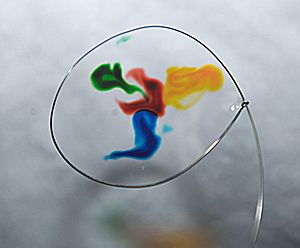Food coloring facts for kids
A food coloring is any substance added to food or drink. Its main job is to change the color of what you eat or drink. Food coloring is used both by big food companies and by people cooking at home.
Contents
Why We Use Food Coloring
People often connect certain colors with certain flavors. For example, you might expect a strawberry candy to be red. The color of food can really change how we think it tastes, from candy to wine.
Because of this, food makers add dyes to their products. One reason is to make the food look like the color customers expect it to be naturally. For instance, without red coloring, glacé cherries would look beige. Food coloring can also be used for fun, like making green ketchup instead of the usual red.
Most people know that foods with bright or unusual colors, like green ketchup, have food coloring. But fewer people know that "natural" foods, such as oranges and salmon, might also be dyed. This helps hide natural changes in their color. The color of foods can change with the seasons. Also, how food is processed and stored can change its color.
Adding colors to food can help companies. It makes sure the food always has the color customers expect or prefer. Here are some main reasons why food coloring is used:
- To fix color lost from light, air, heat, moisture, or storage.
- To hide natural differences in color.
- To make natural colors look stronger.
- To give food a special look, so it's known by its color.
- To protect flavors and vitamins from light damage.
- For decorating, like on cake icing.
Rules for Food Coloring
Food colorings must be tested before they can be used. These tests check that the coloring is not poisonous and has no bad side-effects. Sometimes, different testing groups have different ideas about how safe a coloring is.
In the United States, special numbers called FD&C numbers are given to approved man-made food dyes. These dyes are not found in nature. In the European Union, all approved additives, both man-made and natural, get E numbers.
Most other countries have their own rules. They have lists of food colors that can be used. They also set limits on how much can be used each day.
Natural colors often do not need as much testing. This is true for many places, including the United States FDA. The FDA lists "color additives exempt from certification" for food.
Natural Food Dyes
More and more natural food dyes are being made. This is partly because people are worried about man-made dyes. Here are some examples of natural food dyes:
- Caramel coloring: This is made from caramelized sugar. It is used in cola drinks.
- Annatto: This is a reddish-orange dye from the seeds of the Achiote tree.
- Green dye from chlorella: This comes from a type of algae.
- Cochineal: This is a red dye. It comes from a tiny insect called Dactylopius coccus.
- Beet juice: This gives a red or pink color.
- Turmeric: This spice gives a yellow color.
- Saffron: This spice also gives a yellow color.
- Paprika: This spice gives a red-orange color.
These natural colors are often very pure. This makes it easy to get the exact color needed. They can also be mixed with other materials to help them work better.
Dyes and Lakes
In the United States, approved color additives for food come as "dyes" or "lakes."
Dyes dissolve in water. They do not dissolve in oil. Dyes are made as powders, granules, or liquids. They are used in drinks, dry mixes, baked goods, candies, dairy products, and many other foods. Dyes can sometimes color stools if eaten in large amounts.
Lakes are a mix of dyes and material that does not dissolve. Lakes color things by spreading out. They do not dissolve in oil, but they can spread through oil. Lakes are more stable than dyes. They are great for coloring foods with fats and oils. They are also good for items that do not have enough moisture to dissolve dyes. Common uses include coated tablets, cake mixes, hard candies, chewing gums, and even lipsticks.
Other Uses for Food Coloring

Food dyes are generally safer than regular art dyes. Because of this, some artists use food coloring to make pictures. This is especially true for things like body-painting.
Food colorings can also be used to dye fabric. However, they usually do not stay well on cotton, hemp, and other plant fibers when washed. Some food dyes can stick to Nylon and animal fibers.
Concerns About Food Coloring
In the past, some studies did not find a clear link between ADHD and food dyes. However, newer studies suggest that some man-made preservatives and artificial colors might make the symptoms of ADHD worse in some children. Older studies might not have measured behavior in the best way. Parents' reports about food additives often matched better than some tests.
Several large studies have shown that when artificial ingredients and colors were removed from school food programs, students' school performance improved. Also, there were fewer behavior problems in large groups of students who did not have ADHD.
Some countries have different rules:
- Norway banned products with certain coal tar dyes in 1978. They changed this rule in 2001 to match EU rules.
- Some people might get skin reactions from Tartrazine, a yellow dye. This happens to a very small number of people.
- Studies in rats have looked at the effects of Erythrosine, a red dye.
Images for kids
-
.
Betanin, a magenta dye, mainly produced from beets.
See also
 In Spanish: Colorante alimentario para niños
In Spanish: Colorante alimentario para niños





